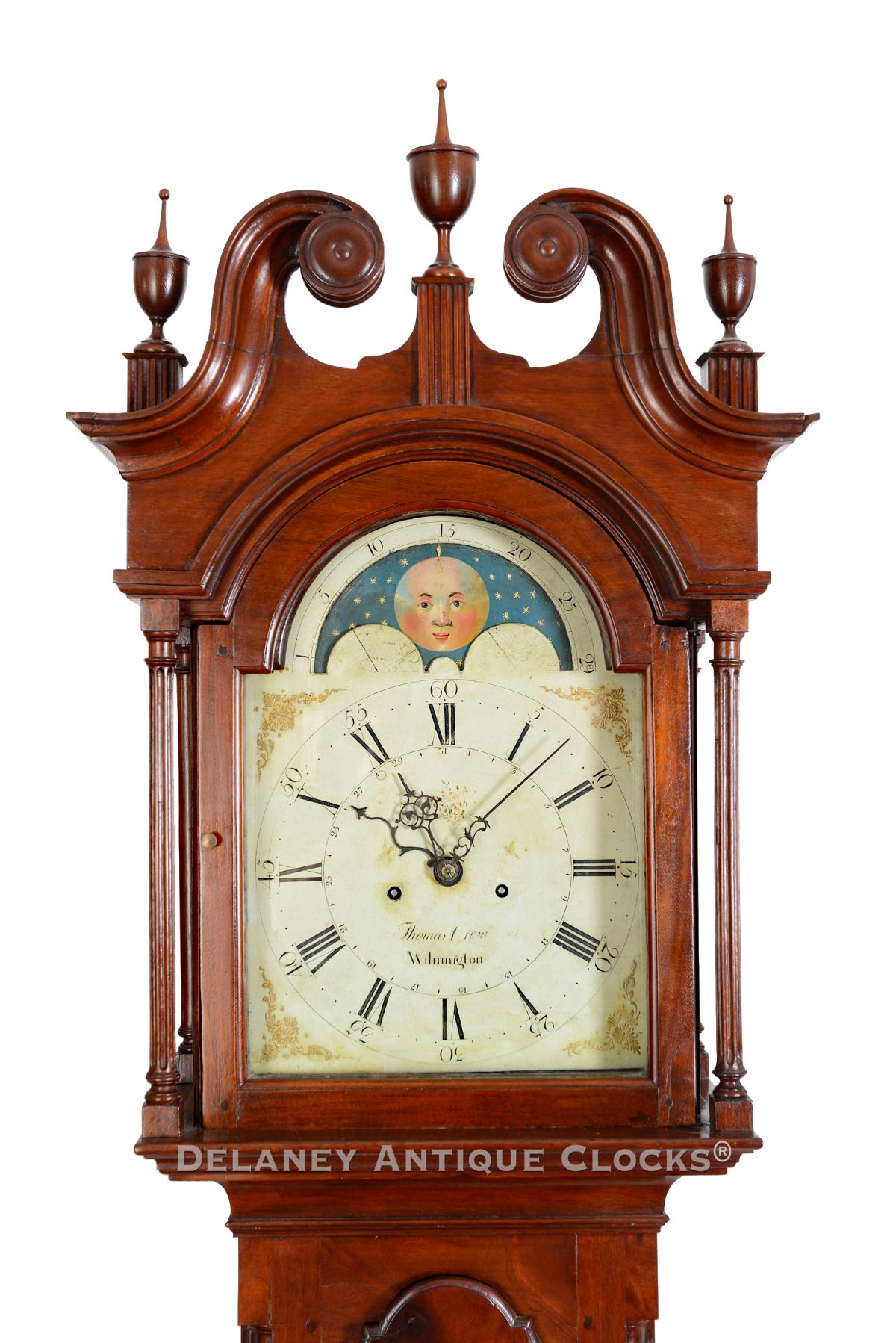Thomas Crow of Wilmington, Delaware. Tall case clock. CCC-28.
Thomas Crow of Wilmington, Delaware, made this handsome walnut case tall clock circa 1790. This example has a strong Philadelphia influence.
This case stands on four boldly formed ogee bracket feet. All four feet have been restored. The base is fitted with an applied panel. This panel features decoratively formed corners extending beyond the square frame. The front corners of the base are fitted with fluted quarter columns that terminate in turned wooden quarter capitals. This same detail is repeated in the waist section. The waist door is nicely shaped and trimmed with a simple molded edge. Through this door, one can access the two cast iron weights and the brass-faced pendulum bob, which is supported on a wooden rod. The bonnet or hood features a bold swan’s neck design. The deep molding or arches terminate in turned wooden rosettes. These moldings have been cut and reapplied. Three fluted finial plinths support turned wooden finials in the form of urns. It is interesting to note that the front corners of this hood are dovetailed. This construction detail is exposed. Four fully turned bonnet columns are located on the four corners of the hood. The two located in the back are smoothly turned. The front two columns are deeply fluted and flank the arched glazed door. This door is fitted with glass and opens to a painted iron dial.
The dial appears to have been painted locally. It is fitted directly to the movement without the use of a false plate. In the arch is a lunar calendar or moon phase mechanism. The moons are painted over a blue field that is also decorated with stars. This dial is signed by the clockmaker in the traditional location. This signature below the center arbor reads, “Thomas Crow / Wilmington.” The spandrel areas are paint-decorated in a simple gilt design. This design is raised off the plain of the dial with applied gesso. The dial displays the hours with Roman numerals. The five-minute markers are in Arabic form. Interestingly, this dial does not incorporate the traditional subsidiary seconds dial. The calendar date is displayed inside the time ring and is indicated with a sweep calendar hand-mounted to the center arbor. This dial is in excellent condition.
This fine movement is constructed in brass and is of good quality. Four-turned pillars support the two brass plates. Hardened steel shafts support the polished steel pinions and brass gearing. The winding drums are grooved. The escapement is designed as a recoil format. The weight-driven movement is designed to run for eight days on a full wind. It is a two-train or a time-and-strike design, having a rack and snail striking system. As a result, it will strike each hour on the hour on a cast iron bell mounted above the movement.
This clock stands approximately 7 feet 11 inches tall.
Inventory number CCC-28.
Thomas Crow was the son of George Crow, who was also a Wilmington, Delaware clockmaker. His birth dates are not known. Thomas appears to have been involved in clockmaking as early as 1770. He became one of Delaware's most prolific and best-known clockmakers. He is recorded to have served the public in several local government positions. In 1805, he moved through Philadelphia and later to West Chester, Pennsylvania, from 1808 to 1810.
Thomas Crow's movements are found in a variety of case styles. It is not unusual to find them in Wilmington area cases but also examples that feature a form more closely related to Philadelphia.
One can find examples of his work in the collections of the Winterthur Museum and the Briggs Museum of Art.




















